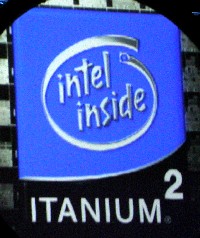Intel Developer Forum Fall 2002 - Day 1: May the show begin
by Anand Lal Shimpi on September 9, 2002 8:52 PM EST- Posted in
- Trade Shows
Itanium 2
 Intel
finished off the keynote with a quick demonstration of Madison, the ~500 million
transistor 0.13-micron successor to Itanium 2. The extremely high transistor
count of Madison comes from its on-die 6MB L3 cache; in another year we’ll
probably be hearing about the 12MB L3 cache of Montecito. As a recap, here’s
Intel’s Itanium line as we know it (taken from Spring IDF 2002):
Intel
finished off the keynote with a quick demonstration of Madison, the ~500 million
transistor 0.13-micron successor to Itanium 2. The extremely high transistor
count of Madison comes from its on-die 6MB L3 cache; in another year we’ll
probably be hearing about the 12MB L3 cache of Montecito. As a recap, here’s
Intel’s Itanium line as we know it (taken from Spring IDF 2002):
McKinley (Itanium 2) - The successor to Itanium is pretty well known already.
McKinley has been in pilot systems since late last year and is already running
at 1GHz. The CPU has a 3MB on-die L3 cache, an 8-stage pipeline, 2 additional
issue ports more integer and load/store units, finally the CPU will have a 128-bit
FSB running at 100MHz quad-pumped.
Madison - The move to 0.13-micron will occur in 2003 with Madison which will
feature up to an incredible 6MB L3 cache located on-die. Madison will be pin-compatible
with McKinley.
Deerfield - Also based on Intel's 0.13-micron process, Deerfield will have less L3 cache than Madison and will be aimed at the entry-level IA-64 market in dual processor configurations only. Deerfield will also be made available in 2003.
Montecito - In 2004 we'll see the first 0.09-micron IA-64 processor from Intel codenamed Montecito. Very little is known about it other than the fact that it will have improved architectural features while maintaining platform & software compatibility with McKinley and Madison/Deerfield.
Final Words
That's it for now, we'll have more coverage from the show later tonight including information on DDR-II, Serial ATA and the first pictures of PCI Express.










0 Comments
View All Comments